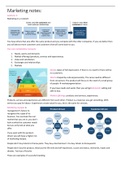Marketing notes:
Lecture 1:
Marketing in a nutshell:
You have others that also offer the same product and you compete with the other companies. If you are better then
you will attract more customers and customers that will come back to you.
Five core marketplace concepts:
1. Needs, wants and demands
2. Market offerings (products, services and experciences.
3. Value and satisfaction
4. Exchanges and relationships
5. Markets
Needs: states of felt deprivation. If there is no need for there will be
no customers.
Wants: shaped by culture/personality. The same need be different
from consumers. The product will focus on the need of a small group
of people → marketsegmentation.
If you have needs and wants then you will get demands: willing and
able to buy.
Market offerings: products and services, experiences.
Products, servies and experiences are different from each other. Product is a material, you get something. With
service you pay for labour. Experiences create value for you, this is the same for services.
Marketing myopia: is
management’s failure to
recognize the scope of its
business. You overlook the real
market that you are in, you don’t
look at what the customer needs
but you only look at what you
offer.
If you work with the product-
driven you will have a higher risk
of marketing myopia.
People don’t buy tickets to theme parks. They buy entertainment. You buy tickets to disneyworld.
People don’t buy the product, they buy the life-stile and self-expression, succes and status, memories, hopes and
dreams. You buy a Porsche
These are examples of succesful branding.
,Customers form expetations about the value and satisfaction. Satisfied customers buy again, dissatisfied customers
switch to competitors. Service determines if the customers are coming back or go to a competitor.
What are suppliers of oatly? Oatfarmers, they can also offer their raw products to different companies.
The middleman of oatly is the supermarket.
The final consumers are people
that like oatmilk. The other
consumers who don’t like
oatmilk are not relevant.
The competitors are other
oatmilk producers, for example
Alpro.
Learning objectives lecture 1:
- Define marketing and outline the steps in the marketing process:
Marketing: the action or business of promoting and selling products or services, including market research
and advertising.
The marketing proces is:
- Identify the core marketplace concepts:
- Identify the key elements of a customer-driven marketing strategy and discuss the marketing
management orientations that guide marketing strategy:
Customer-driven marketing strategy:
1. Segmentation
2. Differentiation
3. Targeting
4. Positioning
, Marketing management orientations that guide marketing strategy:
- Identify concepts and strategies for creating value for customers and capturing value from customers in
return:
1. Relationship building blocks
2. Customer-engagement marketing
3. Consumer-generated marketing
4. Partner relationship management
5. Customer lifetime value
6. Share of customers
7. Customer equity
8. Customer relationship groups
- Describe the major trends and forces that are changing the marketing landscape in this age of
relationships:
1. Digital age
2. Growth of Not-for-Profit Marketing
3. Rapid globalization
4. Sustainable marketing
5. Marketing in a “Post” covid world
Lecture 2:
Ad Valvas marketing case: it didn’t start as a newspaper. In the 60 and 70 young people began to demonstrate
against the regulating bodies. The students and professors wanted more influence in the content of the education.
Ad Valvas reports these clashes and gets fired. They were accused of being biased and the journalist accused that the
board didn’t want the clashes reported. Ad Valvas became independence.
Printing costs 30.000. most part is going to personal
,Marketing management: the art and science of choosing target markets and building profitable relationships with
them. What customers will we serve? (target market) = segmenting, targeting,
positioning. How can we best serve these customers (value proposition)?
Value proposition: set of benefits or values it promises to deliver to customers to
satisfy their needs.
Every brand of car has a different unique value proposition for example BMW has the
promise of sheer driving pleasure. MINI has the world’s most exciting premium small
car brand. Rolls Royce has the pinnacle of automobile luxury. This is what the
customer expects from the product and the brand advertises with this slogan.
If you are good at marketing the customer will demand the product, you don’t have
to convince the customer. The aim of marketing is to make selling superfluous. The
aim is to know and understand the customer so well that the product or service fits
hem and sells itself.
The selling concept → inside-out view proposes that customers, be individual or organizations will not buy enough of
the organization's products unless they are persuaded to do so through selling effort. So, organizations should
undertake selling and promotion of their products for marketing success.
The marketing concept → outside-in view: Focusing on the needs and wants of the customers so the organization
can distinguish its product(s) from competitors’ offerings. Products can be goods, services, or ideas. Integrating all
the organization’s activities, including production and promotion, to satisfy these wants and needs. Achieving long-
term goals for the organization by satisfying customer wants and needs legally and responsibly
Societal marketing: company’s marketing decisions should consider
consumers’ wants, the company’s requirements, consumers long-run
interest and society’s long-run interests.
Marketing mix:
- Product
- Price
- Promotion
- Place
Integrated marketing program: a comprehensive plan that communicates and delivers intended value.
To be successful in the long-term then you should build relationships with customers. Customer relationship
management: the overall process of building and maintaining profitable customer relationships by delivering
superior customer value and satisfaction.
Customer-perceived value: the difference between total customer perceived benefits and customer cost.
Customer satisfaction: the extent to which perceived performance matches a buyer’s expectations.
, In the image you see the balance between customers’
expectations and the performance of the company or the
product. This is de balance to keep the customers happy and
build a relationship with them.
Lecture 3
Customer lifetime value: keep customers and deepen
the relationship with customers. Customers get more
profitable over time. The customer will buy more
expensive products over time because they know the
company. They will tell others about their positive
experiences with the company. If you switch from
products this will mean extra costs for you because
you must spend time to get to know the new product.
It is easier to satisfy a customer with another product
than a new customer who doesn’t have experience
with the brand.
Customer equity:
Brand equity: many people know your brand when it is large.
Value equity: customers assessment based on the offer, its price, and its
convenience.
Retention equity: represents the ability of a brand to retain its customers.
Customer relationship groups:
Butterflies: have a low loyalty but buy much, you need to turn them into loyal
customers.
Strangers: They have a low loyalty, and they spend not much money.
True friends: they create the most value for the company.
Barnacles: they spend not a lot but have a big loyalty.
Big data (unstructured): structured data is an AB test. Unstructured data is data
without a set format. Doesn’t fit in a excel sheet.
Strategic planning: process of developing and maintaining a strategic fit between
the organization’s goals and capabilities, and its changing marketing
opportunities.
Mission statements: the organization’s purpose, what it wants to accomplish in the larger environment.
Starbucks:
Product oriented: we sell coffee and snacks.
Market oriented: to inspire and nurture the human spirit, one person, one cup and one neighborhood at a time.






